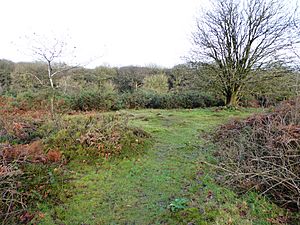Ulverscroft Valley facts for kids
| Site of Special Scientific Interest | |

Ulverscroft Nature Reserve
|
|
| Area of Search | Leicestershire |
|---|---|
| Interest | Biological |
| Area | 110.8 hectares (274 acres) |
| Notification | 1984 |
| Location map | Magic Map |
Ulverscroft Valley is a very special place for nature in Leicestershire, England. It covers about 110.8 hectares, which is a huge area! This valley is so important for its wildlife that it's officially called a Site of Special Scientific Interest (SSSI).
The valley is made up of five different sections. Two of these sections are nature reserves, which are protected areas for plants and animals. The Leicestershire and Rutland Wildlife Trust (LRWT) helps to manage these reserves. One part, called Lea Meadows, is even an old historical site.
Contents
What is Ulverscroft Valley?
Ulverscroft Valley was named a Site of Special Scientific Interest (SSSI) in 1984. This means it's one of the best places in the county for wildlife. Natural England, a group that protects nature, says it has amazing grasslands, heath, woodlands, and wet areas.
More than 200 different types of plants have been found here. The wet parts of the valley are especially rich in plant life. Some parts of the nature reserves are open for people to visit. However, other areas are private land, so you can't go there.
Plants of Ulverscroft Valley
The drier parts of Ulverscroft Valley are home to many grasses. These include sweet vernal grass and crested dog's-tail. You might also find fescues here.
Two rare flowers for this area grow in these dry spots. They are the fragrant orchid and flea sedge.
Wet Area Plants
The wetter parts of the valley have a huge variety of plants. There are 13 different kinds of sedge plants. One of these, bottle sedge, is also rare in the county.
Other beautiful plants found in the wet areas include the heath spotted-orchid and marsh violet. You can also spot marsh arrow grass, quaking-grass, and the unusual Adder's-tongue fern.
Grasslands and Woodlands
The marshy grasslands in Ulverscroft Valley are a mix of different plants. You'll see purple moor-grass, tufted hair-grass, and various rushes and sedges.
There are also patches of heather and bilberry. Look out for the tall spikes of meadow thistle.
Woodland Trees and Birds
The valley has untouched sessile oak woodlands. Underneath these oak trees, you'll find other plants like sallow and European gorse. There's also western gorse, which is a spiky bush.
These woodlands are a great place for birds to live and raise their young. Birds like woodcock and snipe breed here. Sometimes, you might even see a western yellow wagtail or a redstart.

